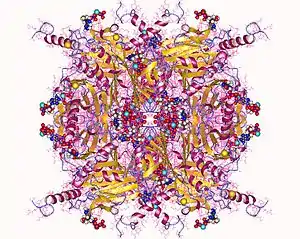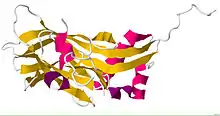Polyhedrin
Polyhedrins are proteins that form the Baculovirus occlusion bodies (also known as Polyhedra), large structures that protect the virus particles from the outside environment for extended periods until they are ingested by other susceptible insect population. The structure of polyhedrin comprises multiple beta strands, three alpha helices, and two pi helices, and are often covered in a polysaccharide coat. The polysaccharide coat confers integrity to the structure of the occlusion bodies, allowing it to remain viable in the environment for up to 40–50 years.[2]

| Polyhedrin | |||||||||
|---|---|---|---|---|---|---|---|---|---|
 The crystal structure of recombinant baculovirus polyhedra.[1] | |||||||||
| Identifiers | |||||||||
| Symbol | Polyhedrin | ||||||||
| Pfam | PF00738 | ||||||||
| InterPro | IPR001746 | ||||||||
| |||||||||
They occur in various viruses including Nuclear polyhedrosis virus (NPV) and Granulovirus (GV). GV is singly enveloped and have one virus particle per occlusion. This is while NPVs have the potential to package multiple virus genomes in an occlusion. The occlusion bodies are usually formed in nucleus of virus infected cells approximately 2 days after the infection.
References
- PDB: 2WUX; Ji X, Sutton G, Evans G, Axford D, Owen R, Stuart DI (January 2010). "How baculovirus polyhedra fit square pegs into round holes to robustly package viruses". EMBO J. 29 (2): 505–14. doi:10.1038/emboj.2009.352. PMC 2824454. PMID 19959989.
- Rohrmann (1986). "Polyhedrin structure". J Gen Virol. 67 (8): 1499–513. doi:10.1099/0022-1317-67-8-1499. PMID 3525744.